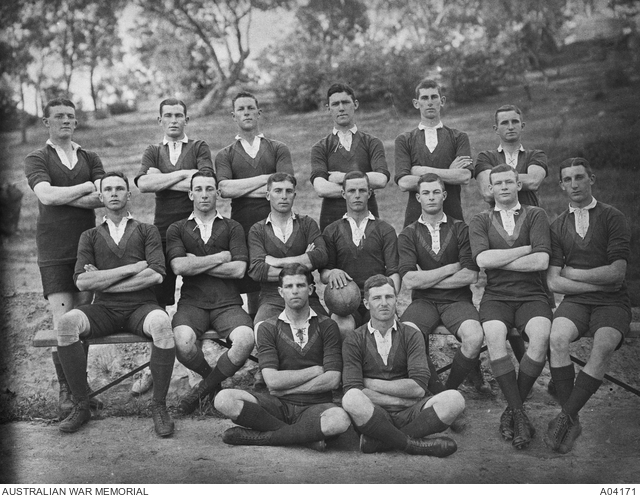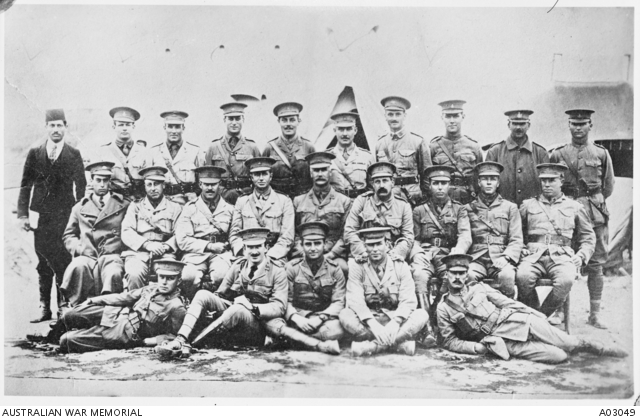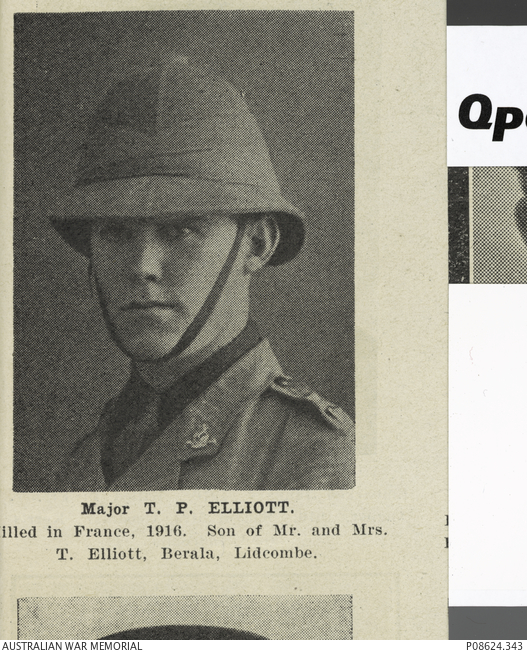| Ranks Held | Lieutenant, Major |
|---|---|
| Birth Date | 1894-01-18 |
| Birth Place | Australia: New South Wales, Sydney, Marrickville |
| Death Date | 1916-07-19 |
| Death Place | France |
| Final Rank | Major |
| Service | Australian Imperial Force |
| Units |
|
| Places | |
| Conflict/Operation | First World War, 1914-1918 |
Major Thomas Patrick Elliott


Thomas Patrick Elliott was born on 18 January 1894 at Marrickville, New South Wales, to Thomas and Mary Ellen Elliott (née Kenny). He attended school at Marrickville before entering the Royal Military College Duntroon in 1912 at the age of eighteen. Elliott quickly distinguished himself academically at Duntroon, consistently finishing in the top few of his class over the next three years, and was athletic champion in 1914. With the outbreak of the First World War, cadets of the First and Second Classes were graduated specially for active service abroad in November 1914, with half the officers being sent to the infantry and half to the light horse. Elliott, in Second Class at the time, graduated as a lieutenant and was assigned to “B” Squadron of the 7th Light Horse Regiment (LHR). The 20-year-old embarked from Sydney aboard the troopship HMAT Ayrshire on 20 December 1914.
Elliott and the 7th LHR arrived in Egypt in early February 1915 and in May were deployed without their horses to Gallipoli to support the infantry. He was the Regimental Observation Officer until July 1915 when he became the Machine Gun Officer. In September, Elliott was evacuated to Malta with enteric fever and rejoined the Australians in Egypt in January 1916. Several days after arriving in Egypt he was appointed 2nd Light Horse Brigade Machine Gun Officer and was promoted to the rank of captain. In March, Elliott was specifically requested by the commanding officer of the 15th Infantry Brigade, Brigadier General Harold Edward (Pompey) Elliott, to lead a company in the newly-formed 60th Infantry Battalion, part of Pompey’s efforts to build up fine officers around him in the fledgling brigade. The strong leadership qualities and character that had attracted Pompey’s attention to the young captain had their effect and Elliott’s company soon became a well disciplined and trained fighting unit. In June he was promoted to major and was appointed second-in-command of the battalion under another fine young officer, Major Geoffrey Gordon McCrae. In mid-June the men and their battalion left Egypt for France, arriving at the end of the month.
After a fairly quiet introduction to life on the Western Front, the 15th Infantry Brigade was committed to the upcoming Allied assault at Fromelles. Knowing that Fromelles would likely be a massacre, but powerless to dispute his British superiors, Pompey tried in vain to keep Elliott out of the action, even transferring him to brigade headquarters. However, Elliott’s own desire to return to the battalion and McCrae’s pleas for the return of his brilliant second-in-command eventually won out. Elliott returned to the 60th Battalion and set about finalising the arrangements for the attack that the battalion would make at Fromelles on 19 July 1916, committed to making a nearly hopeless situation as successful as realistically possible. Sadly, in the ensuing attack the battalion was virtually wiped out and Elliott was killed whilst encouraging the men of the second wave forward. He was 22 years old. Thomas Patrick Elliott is commemorated at VC Corner Australian Cemetery and Memorial, Fromelles, Lille, Nord Pas de Calais, France.



